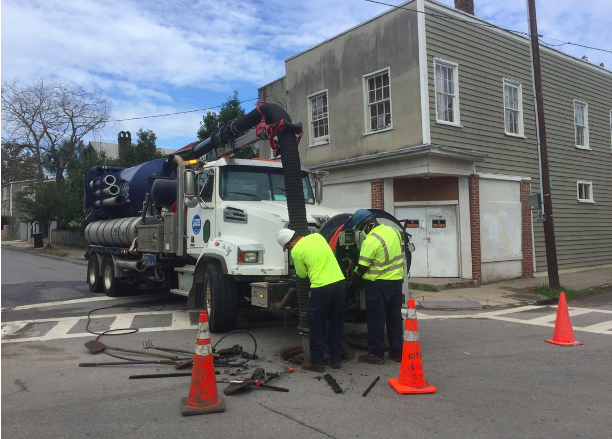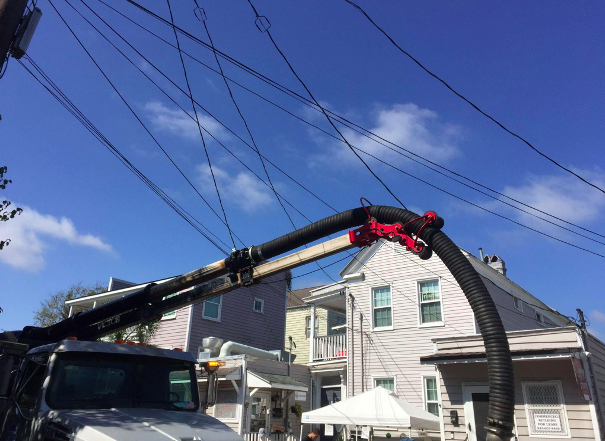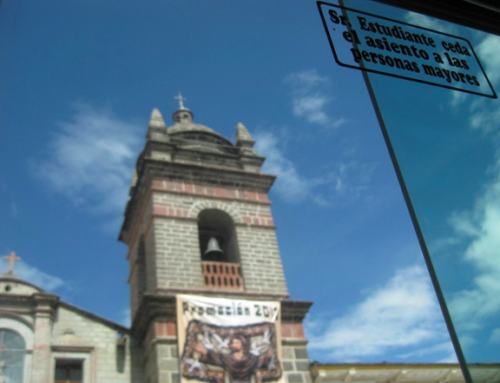
Two stormwater technicians work to clean a clogged drainage line. Photo credit: Brian Walter.
I am grateful I was given earplugs. The high-pitched roar of the Vactor 2100 Plus stormwater truck puts urgency in the steps of pedestrians and motivates nearby residents to quickly snap their windows and doors shut. Standing in the middle of the street, within a boundary marked off with cones, I watch as two stormwater technicians, Samir and Ray, wordlessly communicate through the mechanical din and work to clean out the stormwater pipes of this frequently flooding street in coastal Charleston, South Carolina.
Samir unspools the powerful hose from the front of the truck, threading it through an open manhole and into the large stormwater pipe running down the center of the road. Once the hose is in place, he begins scouring the system with high-pressure water by sending powerful jets in both directions: forward to break up debris, and backward to gather up dislodged material into the catch basin. This debris is an unpleasant slurry of urban coastal life: bottles and cans, muddy sediment from yards and construction sites, and mixed organic material like roots and oysters. We monitor the torrent of water rushing back towards us as Samir feeds the hose deeper and deeper into the system, mud splattering on our clothing. The water is dark and rich with sediment for now, but it trends ever so slightly clearer over time, opening up space for water to flow freely during storm events.
Just a few weeks ago, after a sharp but characteristic rainstorm, I trudged through knee-deep floodwaters in this neighborhood on Charleston’s low-lying and historically Black Eastside. Yards were flooded and cars destroyed. Residents had taken matters into their own hands, blocking off streets with makeshift barriers, clearing out clogged catch basins, and pushing vehicles to higher ground. Though this poorly draining neighborhood has always been prone to flooding, a condition closely related to racial segregation, inundation has worsened in recent years as sea-level rise contributed to a 75% increase in flooding. It is estimated that Charleston floods every four to five days. Regularly cleaned pipes prevent blockages and allow water to flow freely through the system—essential for mitigating dangerous and damaging flooding.

Compound flooding in Charleston’s Eastside Neighborhood. Photo credit: Brian Walter.
Samir signals to Ray, who sits at the controls of this powerful machine, when he needs more slack in the line or an adjustment in the water pressure. Eventually, Samir calls Ray over to examine the backflow and determine whether it is clean enough to reel the hose back in. When the pipe appears clear of sediment, Ray maneuvers the hydraulic boom on the top of the truck to guide the 8-inch diameter vacuum tube into the manhole, so he can begin carefully hoovering up the collected debris into the truck’s 1,200-gallon tank. After this they will pack up their gear and repeat the process on the next block, slowly moving down the system.
Caring in and Caring for an Unsettling World
Through this methodical process of maintenance, Samir and Ray come to intimately understand the stormwater system. As they feed the hose through the pipes, they feel for blockages or cave-ins, interpreting the feedback they sense in the line as it bumps and snags on its journey. When they find issues, Samir and Ray respond with creative, context-specific fixes, or pass their knowledge on to specialists with different tools to work on the system. These acts of maintenance and repair, which “demand attuned attentiveness and adaptive tinkering” (Mol et al. 2010, 15), neatly fit the classic definitions of care work in science and technology studies (Bellacasa 2017; Jackson 2014; Mol 2010).
By caring for the pipes, Samir and Ray’s work helps make life in the predominantly Black Eastside neighborhood more livable. As they clear sediment, they maximize the capacity of this undersized stormwater system, helping water drain more swiftly and lessening the damage from ever more frequent flood events.

Bricks and other refuse removed from a catch basin. Photo credit: Brian Walter.
In recent literature, important attention has been paid to “unsettling” care and the assumptive positive qualities it beckons towards (Martin et al. 2015; Murphy 2015). Care is “shot through” with power asymmetries “enabled through non-innocent historically and spatially layered distributions of belonging and alienation, comfort, and unease” (Murphy 2015, 721). However, this collection focuses not just on unsettling care but imagining what it means to care in and for a world that is unsettling. How might we think anew about valuable care work, such as the stormwater maintenance described above, when it has had the paradoxical effects of making an unjust and unsettling world more livable while maintaining its racial foundations?
In the South Carolina Lowcountry, the landscape is unsettling both affectively–as a space of continuing histories of racialized violence–and materially, as rising seas continue to challenge the viability of living on the coast. Take Charleston’s Eastside as an example. This low-lying neighborhood sits less than a mile from the docks where 40% of enslaved Africans were forced to enter the United States. For most of its recent history, the Eastside had been a predominantly Black and working-class refuge from the rest of the city. However, in the mid-nineteenth century city-led efforts for “slum clearance” leveled Black property in the neighborhood and replaced it transportation infrastructure and racially segregated public housing, Now legally integrated, Eastside public housing is still predominantly Black and permanently adorned with green “bathtub rings” formed by frequent flooding around units, which emerges from the stormwater systems during the highest tides. Black Eastsiders today worry about this flooding in combination with rapid gentrification, which together have contributed to significant Black displacement. In the past forty years years, the Charleston peninsula transformed from being two-thirds Black to two-thirds white.
Various laborers, in work that is underpaid and racialized (Samir and Ray are both non-white) provide the daily care that is necessary to prevent the Eastside and the rest of the region from facing the constant inundation of rising tides. This includes clearing out the sediment gathered in stormwater pipes discussed above, but also the maintenance of other coastal defenses: buttressing earthen dikes with layers of mud, building hard seawalls, and excavating overgrown drainage ditches. Black community leaders have long argued that this work is essential, yet racially uneven.
Maintaining Dispossession
But what is being maintained when stormwater pipes are cared for (Graham and Thrift 2007)? The caring work of stormwater technicians like Samir and Ray and other workers maintaining different hydrological systems helps ease flooding in neighborhoods like the Eastside, yet ultimately cannot address the existential issues residents face. Even with clean drainage systems, rising seas and increasingly powerful hurricanes pose threats to residents that grow graver by the day, while gentrification continues to pressure Black homeowners to leave this community.
In my fieldwork, community members frequently described maintenance work as an index of state care (Carse 2019). Black Lowcountry residents, in particular, pointed to the lack of maintenance and care of their ditches and stormwater pipes as proof that the city did not support their communities. When delayed maintenance finally arrived, the Black residents I spent time with were happy for relief but expressed skepticism about the intentionality of these actions. As gentrification continues to drive displacement in a red-hot housing market, residents connected increased maintenance with the decrease of the Black population.
To their point, this maintenance work might even accelerate gentrification, making the neighborhood more palatable for wealthy newcomers who can afford to rebuild flooded homes or lift them out of the floodplain. Further, as a show of state-sponsored care, the presence of stormwater trucks, with their flashing lights and penetrating noise, can be used as charismatic “proof” that Black communities are not being ignored, as they claim (with strong evidence). As a reformist environmental solution that does not dismantle the foundations of racist urban ecologies (Hare 1970), this care work contributes to discourses that silence Black Charlestonians’ claims for justice, while ultimately leaving them at risk.
Caring in the Gaps
Jessica Barnes (2017) explores a similar quandary in her examination of state-led maintenance of water infrastructures in the Nile. In this work, she moves against a romanticization of care and repair to argue that state maintenance of water infrastructures is actually the act of maintaining the state itself, including its authority over the environment. Barnes contrasts this with individual acts of care that strengthen and maintain communal ties among farmers.
Barnes’ argument helpfully illuminates a central dynamic here: how stormwater trucks end up around specific parts of the city at particular times, easing contradictions and inequities that might otherwise prompt challenges to state power. But perhaps a similar distinction can be made within the actions of state-led care itself. Though state maintenance on the Eastside is certainly used to legitimize control over the landscape and perpetuate racial hydrologies, this does not fully capture Samir and Ray’s labor.
Samir and Ray are state technicians, but their care work extends beyond their job description. As we prepare to move to a new Eastside drainage system, I ask Ray about the nature of his work. He describes it as “a first priority,” telling me that during rain events, he will return to spots he has cleaned—off the clock—just to see if his work has been effective. He has close friends in the neighborhood, so it is personal to him.
Like most undervalued care work, stormwater maintenance involves uncompensated labor. Samir and Ray extend outside of their job descriptions throughout the day tailoring their work to particular community needs. They will clean lines outside of the regular maintenance cycle at the request of residents we speak with, pull excess debris out of catchment basins that are technically “clean enough,” and clip roots that are growing into drainage systems even if they do not pose an immediate issue. In doing so, they transform elements of what might be understood as state charity into forms of mutual aid that have always been central to Black ecologies, communities, and commons (Roane 2018; Reese and Johnson 2022; Hosbey and Roane 2021).
These actions—which unfold within the work of state maintenance but also exceed its guidelines—point to the possibility that community-sustaining care can occur even within state projects maintaining racial geographies. Perhaps because of this personal attention, Samir and Ray are greeted warmly by residents, on foot or behind the wheel, who wave or hail our group with a soft honk as they move by.
This is, of course, still unsettling. The extra maintenance attention is unpaid. Even with it, Eastside residents contend with insufficient drainage infrastructure and will continue to face the racialized threat of climate-driven dispossession. Though Samir and Ray’s work will not and cannot fundamentally change this future, their efforts point to possibilities for community-affirming care to exist even within the small spaces left open in the tangled interstices of the state. Edges erode, and as rising seas continue to unsettle this world, more spaces for care and new futures may open in the cracks, fissures, and gaps of old foundations.

Maneuvering a stormwater truck through low-hanging wires. Photo credit: Brian Walter.
References
Barnes, Jessica. 2017. “States of Maintenance: Power, Politics, and Egypt’s Irrigation Infrastructure.” Environment and Planning D: Society and Space 35 (1): 146–64. https://doi.org/10.1177/0263775816655161.
Puig de la Bellacasa, María. 2017. Matters of Care: Speculative Ethics in More than Human Worlds. Minneapolis: University of Minnesota Press.
Carse, Ashley. 2019. “Dirty Landscapes: How Weediness Indexes State Disinvestment and Global Disconnection.” In Infrastructure, Environment, and Life in the Anthropocene, edited by Kregg Hetherington, 97-114. Durham: Duke University Press.
Graham, Stephen, and Nigel Thrift. 2007. “Out of Order: Understanding Repair and Maintenance.” Theory, Culture & Society 24 (3): 1–25
Hare, Nathan. 1970. “Black Ecology.” The Black Scholar 1 (6): 2–8.
Hosbey, Justin, and J. T. Roane. 2021. “A Totally Different Form of Living: On the Legacies of Displacement and Marronage as Black Ecologies.” Southern Cultures 27 (1): 68–73.
Jackson, Steven J. 2014. “11 Rethinking Repair.” Media Technologies: Essays on Communication, Materiality, and Society, 221–39.
Martin, Aryn, Natasha Myers, and Ana Viseu. 2015. “The Politics of Care in Technoscience.” Social Studies of Science 45 (5): 625–41. https://doi.org/10.1177/0306312715602073.
Mol, Annemarie, Ingunn Moser, and J. Pols, eds. 2010. Care in Practice: On Tinkering in Clinics, Homes and Farms. Bielefeld: Transcript.
Murphy, Michelle. 2015. “Unsettling Care: Troubling Transnational Itineraries of Care in Feminist Health Practices.” Social Studies of Science 45 (5): 717–37.
Reese, Ashanté M., and Symone A. Johnson. 2022. “We All We Got: Urban Black Ecologies of Care and Mutual Aid.” Environment and Society 13 (1): 27–42. https://doi.org/10.3167/ares.2022.130103.
Roane, J. T. 2018. “Plotting the Black Commons.” Souls 20 (3): 239.
Brian Walter is an Assistant Professor of anthropology at James Madison University. His research and teaching interests bring together work in environmental anthropology, critical heritage studies, racial ecologies, and environmental justice to untangle racialized landscapes in the US South. His current research on sea level rise in the South Carolina Lowcountry is conducted in collaboration with multiple grassroots anti-flooding groups pursuing just futures for the region




